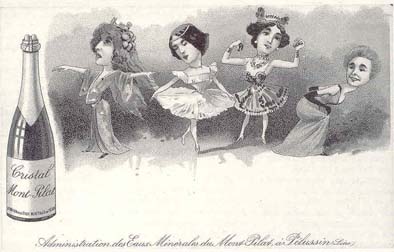PAINEL
15

1.
THEATRE ANTOINE - Theatre a bon marche. Assinado: Louis Malteste.
2. THEATRE SARAH BERNHARDT. Ed.H.C.Wolf. Paris. Assinado: Ch. Caban.
3. CRISTAL MONT-PILAT. Administration des Eaux Minerales du Mont-Pilat,
a Pelussin (Loire). (Sarah Bernhardt, Cleo de Merode, La Belle Otero
e Yvette Guilbert).
4. Propriete exclusive de la Societe des CHAUSSURE RAOUL. (Yvette Guilbert).
Imp.Lemercier. Assinado: Ludvic.
5. Propriete exclusive de la Societe des CHAUSSURE RAOUL(Cecile Sorel).
Imp. Lemercier. Assinado: Ludvic.
6. THE DAUGHTERS OF BABYLON, de Wilson Barret. Drama em 4 atos, Londres,
s/assim.
7. THE MERRY WIDOW, de Franz Lehar. Com Lily Elsie. Londres, 1907. S/assin.
8. MISS ELIZABETH'S PRISONER. Com Lewis Waller. Imperial Theatre (Londres,
1904). Ed.David Allen & Son. Assinado: Buchel.
9. ROMANCE, de Edward Sheldon. Com Doris Keane. Lyric Theatre, Londres,
1915, s/assim.
10. Victor Boucher em TA BOUCHE...! Comedia Musical em 3 atos de Yves
Mirande. Theatre Daunou. Assinado: Sem:
11. COLLECTION ARTISTIQUE DU VIN DESILES. Com inscrição
e assinatura fac-similada. Amelie Dieterle. Fot. Reutlinger, Paris.
12. COLLECTION ARTISTIQUE DU VIN DESILES. Com inscrição
e assinatura fac-similada. Cora Laparcerie-Richepin. Fot.Reutlinger,
Paris.
13. COLLECTION ARTISTIQUE DU VIN DESILES. Com inscrição
musical e assinatura fac-similada. Yvonne Dubel, soprano francesa da
Ópera de Paris. Fot.Reutlinger.
PUBLICIDADE
O
Cartão-postal surgiu no Império Austro-Húngaro em
1869 e sucessivamente foi sendo adotado por todos os países da
Europa e do Novo Mundo. Desde então foi utilizado como um eficaz
veículo de comunicação e publicidade, ganhando novo
impulso quando deixou de ser uma concessão oficial dos governos
para se tornar uma atividade da livre iniciativa.
Na virada do século, o aperfeiçoamento e popularização
desse tipo de correspondência, propiciado pelo seu baixo custo de
postagem e pela sua crescente qualidade técnica de impressão,
permitiram seu desenfreado colecionamento e sua larga utilização
como um importante modo de publicidade em todo o mundo. Ilustradores que
então se afirmavam, criando para o cartão-postal um universo
de beleza, voltaram-se também para a concepção de
cartões publicitários, especialmente encomendados. Assim,
os mais diferentes produtos e estabelecimentos, como os mais famosos teatros,
propagaram seus nomes e grandes artistas surgiram em pequenas e belas
litografias, unindo seu prestígio a imagens de conceituadas empresas
ou anunciando espetáculos que protagonizavam.
Entre os copiosos cartões-postais
fotográficos de publicidade, relacionados ao mundo do Teatro, a
série francesa Collection Artistique du Vin Desiles (1906) foi
a que mais utilizou personalidades em seus reclames: aproximadamente 155
artistas contemporâneos exaltaram as qualidades do vinho.
ADVERTISEMENT
The
postcard first appeared at the Austro-Hungarian Empire in 1869 and was
successively adopted by every country in Europe and in the New World.
Since then it has been used as an efficient communication and advertisement
medium, gaining a new impulse when it became no longer na official concession
but a free enterprise initiative.
At the turn of the century, the improvements and popularization of such
type of correspondence, made possible by its low postage and growing technical
printing quality, allowed for its unbriddled collecting and large utilization
as an important means of advertizing throughout the world. Illustrators
who were starting to assert themselves, creating a world of beauty for
the postcard, turned towards the creation of advertising cards that were
specially ordered. Thus, the most differentiated products such as the
popular theatres, spread their names, and great artists appeared on small
and beautiful lithographies joining their prestige to the images of well
known entreprises, or announcing the plays in which they performed.
Among the plentiful photographic
advertising postcards related to the theater world, the French series
Collection Artistique du Vin Desiles (1906) was the one o use a greater
number of personalities in its propaganda: aproximately 155 contemporarian
artists exhalted the qualities of the wine.